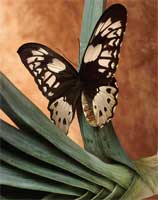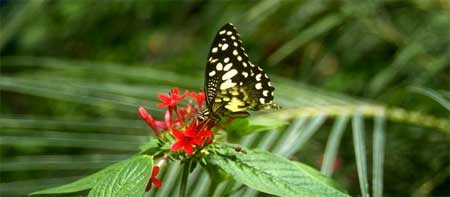|

Diet: Butterflies live primarily on nectar from flowers. Some also derive nourishment from pollen, tree sap, rotting fruit, dung, and dissolved minerals in wet sand or dirt. Butterflies are also pollinators, and some -- like the  monarch -- migrate over great distances each year. monarch -- migrate over great distances each year.
A taste for salt: Several species of butterflies need more sodium than provided by
the nectar they drink from flowers. As such, they are attracted
to the sodium in salt (which the males often give to the females
to ensure fertility). As human sweat contains significant quantities
of salt, they sometimes land on people.
Confused identity: Butterflies are often confused with moths, but there are a few
simple differences between them, including colour, habits, and pupating
appearance. The easiest way to tell them apart is their appearance
when at rest -- butterflies tend to rest with their wings spread
open, while moths tend to rest with their wings closed.

 Funnel eggs: Butterfly eggs consist of a hard-ridged outer layer of shell, called
the chorion. This is lined with a thin coating of wax which prevents
the egg from drying out before the larva has had time to fully develop.
Each egg contains a number of tiny funnel-shaped openings at one
end, called micropyles; the purpose of these holes is to allow sperm
to enter and fertilize the egg. Butterfly and moth eggs vary greatly
in size between species, but they are all either round or oval in
shape. Funnel eggs: Butterfly eggs consist of a hard-ridged outer layer of shell, called
the chorion. This is lined with a thin coating of wax which prevents
the egg from drying out before the larva has had time to fully develop.
Each egg contains a number of tiny funnel-shaped openings at one
end, called micropyles; the purpose of these holes is to allow sperm
to enter and fertilize the egg. Butterfly and moth eggs vary greatly
in size between species, but they are all either round or oval in
shape.
Eating machines: Butterfly larvae, or caterpillars, are multi-legged eating machines.
They consume plant leaves and spend practically all of their time
in search of food. When the larva exceeds a minimum weight at a
particular time of day, it will stop feeding and begin "wandering"
in a quest for a suitable pupation site, usually the underside of
a leaf. The larva transforms into a pupa (chrysalis), which then
transforms into a butterfly by metamorphosis. To transform from
the miniature wings visible on the outside of the pupa into large
structures usable for flight, the pupal wings must absorb a great
deal of nutrients. If one wing is surgically removed early on, the
other three will grow to a larger size.
Growing to fly: The adult, sexually mature, stage of the insect is known as the
imago. As Lepidoptera, butterflies have four wings that are covered
with tiny scales, but, unlike moths, the fore- and hindwings are
not hooked together, permitting a more graceful flight. After it
emerges from its pupal stage, a butterfly cannot fly for some time,
because its wings have not yet unfolded. A newly-emerged butterfly
needs to spend some time 'inflating' its wings with blood and letting
them dry, during which time it is extremely vulnerable to predators.

All text is available under the terms
of the GNU Free Documentation License
|